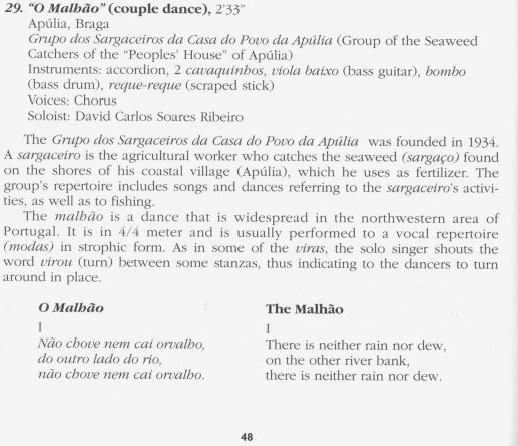The Malhão is a Portuguese circle dance and song in 2/4 time from Minho and Douro Litoral in the northwestern region of Portugal. But there were also versions found in Estremadura.
The name "malhão" probably originated from an agricultural instrument and in the days when it was danced in the villages, it had a different choreography, women and men lined up, facing each other. They came closer and further away successively and beat the rhythm with their feet. The end of the dance happened, when everyone closed the circle and jumped.
The form of alternate endings derives from the cossante or cosaute, a courtly sung dance originating in 11th Century France. The dance is also preserved in Malacca.
The song also exists as the base of a fado, with local variations as in the Malhão de Cinfães, Malhão de Águeda, and Malhão de S. Simão, all recorded by Amália Rodrigues.
Other variations: Malhão de Souto and Malhão Minhoto.
In 1955 the Grupo de Cantas e Cramóis (from Pias, Cinfaes) under the direction of Augusto de Amaral, recorded a version of this traditional as "Malhão de Cinfães"
(o) Grupo de Cantas e Cramóis (Cinfães) (1955) (as "Malhão de Cinfães")
Recorded 1955 in the Valentim de Carvalho studios in Paço de Arcos, Lisbon
Matrix OPC 1056
Released in 1956 A Voz Do Dono MQ 181
Re-released in 1957 on His Master's Voice (for the UK market)
After Amália Rodrigues had global success with her version of the song, it was reissued in 1967 on the next EP
Also re-issued on CD in the compilation "Folklore: Minho", released in 1998 by EMI-Valentim de Carvalho.
Listen here:
In 1966 Amália Rodrigues recorded her version of "Malhão de Cinfães", with an arrangement by Joaquim Luis Gomes
(c) Amália Rodrigues (1966) (as "Malhão de Cinfães")
Recorded in 1965
Released in 1966 on Columbia SLEM 2254
Listen here:
In 1959 the Rancho Típico Cancioneiro De Águeda (from Águeda in the middle region of Portugal) under the direction of Armando Leça, recorded a version of this traditional as "Malhão"
(c) Rancho Típico Cancioneiro De Águeda (1959) (as "Malhão")
Listen here:
In October 1967 Amalia Rodrigues recorded her version of "Malhão De Águeda", which was not released until 1971 on the album Amália Canta Portugal 2.
(c) Amália Rodrigues (1968) (as "Malhão De Águeda")
Listen here:
In 1958 the Rancho Folclórico De S. Simão Da Junqueira (from North Portugal)) under the direction of Hugo Ribeiro, recorded a version of this traditional as "Malhão de S. Simão"
(c) Rancho Folclórico De S. Simão Da Junqueira (1958) (as "Malhão de S. Simão")
Re-released in 1966 on the next EP
Listen here:
In 1972 Amalia Rodrigues also recorded this version of "Malhão de S. Simão". which was released in 1972 on the album Amália Canta Portugal III.
(c) Amália Rodrigues (1972) (as "Malhão de S. Simão")
Recorded August 1972 in the Valentim de Carvalho studios in Paço de Arcos, Lisbon
Listen here:
In 1957 a folkgroup from Gulpilhares (a city in the Northern region of Portugal) recorded another variation of "Malhão".
(c) Rusga de Gulpilhares (1957) (as "Malhão")
In 1973 they recorded a new version of "Malhão". It was this version that eventually conquered the world, with versions by Roberto Leal, Johnny Rodrigues and Amalia Rodrigues.
(c) Rancho Regional de Gulpilhares (1973) (as "Malhão")
SEE ALSO: Rancho Regional de Gulpilhares
Listen here:
With his adaptation of "O Malhão" Roberto Leal had a hit in Brazil in 1973.
(c) Roberto Leal (1973) (as "O Malhão")
Listen here:
The next year Johnny Rodrigues (no relation to Amália) had a Nr 1 in The Netherlands, in Belgium and in Portugal with his "adaptation" of "O Malhão" (retitled "Hey Mal Yo!")
During its chart run, doubts were raised about the origin of Rodrigues's song and whether he actually sang on it. Dutch newspaper Het Vrije Volk wrote in April, 1975 that Johnny's rendition was a note-by-note copy of an earlier version of the song, performed by Brazilian singler Roberto Leal, originally released in 1973 as "O Malhão". The newspaper even wondered whether it was actually Leal's recording which was issued in the Netherlands with Rodrigues simply miming to that song.
(c) Johnny & Orquesta Rodrigues (1974) (as "Hey Mal Yo!")
Listen here (and judge for yourself if it's actually Roberto Leal, who's singing !!)
In response to this all, Amália Rodrigues also recorded this version of "O Malhão" in 1975, but with the original traditional title "Malhão"
(c) Amália Rodrigues (1975) (as "Malhão")
In the Netherlands Amalia's 1975 version of "Malhão" was retitled "Hey Mal Yo!"
Listen here:
A very authentic version was recorded by Grupo dos Sargaceiros da Casa do Povo da Apulia
Listen here:
In 1956 Potuguese singer Maximiano de Sousa, better known as Max, recorded a song called "Bate O Pé", which most likely is just his adaptation of the "Malhão" song and dance.
Listen here:
Roberto Leal, who already had recorded his adaptation of "O Malhao" in 1973, also recorded an adaptation of "Bate O Pé" in 1977, which was also a big succes in Brazil and Portugal.
(c) Roberto Leal (1977) (as "Bate O Pé")
Listen here:
In 1977 Jona Lewie wrote an English version of "Bate O Pé", which he recorded as a member of Terry Dactyll and the Dinosaurs.
(c) Terry Dactyll and the Dinosaurs with Jona Lewie (1978) (as "Come Away")
Listen here:






















Geen opmerkingen:
Een reactie posten